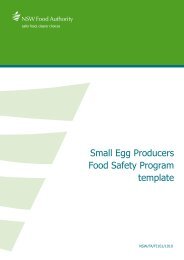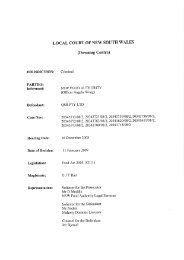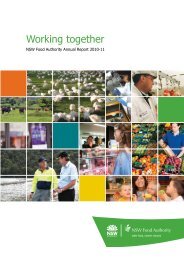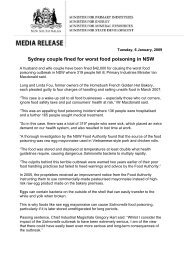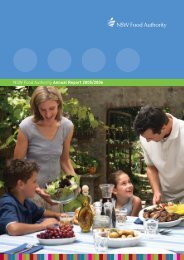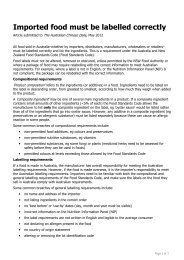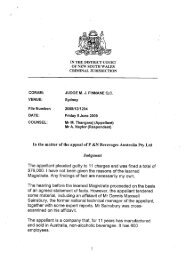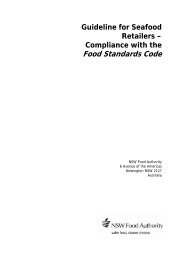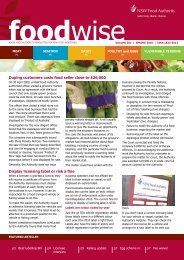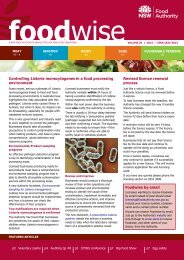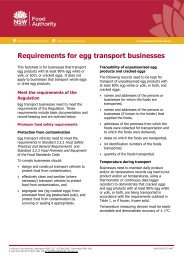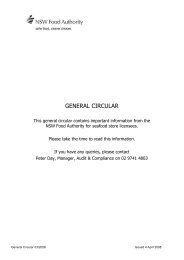Guidelines for food businesses at temporary events - NSW Food ...
Guidelines for food businesses at temporary events - NSW Food ...
Guidelines for food businesses at temporary events - NSW Food ...
You also want an ePaper? Increase the reach of your titles
YUMPU automatically turns print PDFs into web optimized ePapers that Google loves.
CONTENTS1 INTRODUCTION ............................................................................................. 41.1 Wh<strong>at</strong> is a <strong>temporary</strong> event? ....................................................................................... 41.2 Oblig<strong>at</strong>ions of people selling <strong>food</strong> ............................................................................... 41.3 Wh<strong>at</strong> agencies en<strong>for</strong>ce the Act and Code? .................................................................. 52 ADMINISTRATION .......................................................................................... 62.1 Notific<strong>at</strong>ion ............................................................................................................... 62.2 Licensing .................................................................................................................. 62.3 Council approvals ...................................................................................................... 62.4 <strong>Food</strong> Safety Supervisor .............................................................................................. 62.5 Inspections ............................................................................................................... 62.6 Fees and charges ...................................................................................................... 73 CONDITIONS OF OPERATION ......................................................................... 83.1 Loc<strong>at</strong>ion of <strong>food</strong> stalls ............................................................................................... 83.2 Toilets ...................................................................................................................... 83.3 Maintenance ............................................................................................................. 83.4 Garbage and recyclable m<strong>at</strong>ter .................................................................................. 83.5 Animals and pests ..................................................................................................... 83.6 Children in <strong>food</strong> stalls ................................................................................................ 83.7 W<strong>at</strong>er and ice ........................................................................................................... 83.8 Electricity and gas supplies, fire extinguishers and work safety .................................... 93.9 Pollution prevention .................................................................................................. 94 FACILITIES ...................................................................................................104.1 Construction of <strong>temporary</strong> <strong>food</strong> stalls ....................................................................... 104.2 Fixtures .................................................................................................................. 104.3 Cleaning, sanitising and hand washing facilities ......................................................... 104.4 Waste disposal ........................................................................................................ 115 FOOD HANDLING ..........................................................................................125.1 <strong>Food</strong> suppliers ........................................................................................................ 125.2 Preparing <strong>food</strong> <strong>at</strong> home ........................................................................................... 125.3 Transport of <strong>food</strong> to <strong>events</strong> ..................................................................................... 125.4 <strong>Food</strong> storage .......................................................................................................... 125.5 Potentially hazardous <strong>food</strong>s and temper<strong>at</strong>ure control ................................................ 135.6 Cross contamin<strong>at</strong>ion ................................................................................................ 135.7 <strong>Food</strong> display ........................................................................................................... 145.8 Crockery, wrappings and packaging ......................................................................... 145.9 Single-use items ..................................................................................................... 145.10 Skills and knowledge ............................................................................................... 145.12 Staff illness ............................................................................................................. 155.13 Requirements <strong>for</strong> <strong>food</strong> handlers ............................................................................... 15<strong>Guidelines</strong> <strong>for</strong> <strong>food</strong> <strong>businesses</strong> <strong>at</strong> <strong>temporary</strong> <strong>events</strong> <strong>NSW</strong>/FA/FI146/1302 Page 2 of 23
5.14 Hand washing ......................................................................................................... 155.17 Labelling ................................................................................................................. 166 CHECKLIST FOR TEMPORARY FOOD STALL .....................................................186.1 Temporary <strong>food</strong> stall layout ..................................................................................... 186.2 Temporary <strong>food</strong> stall checklist .................................................................................. 197 CONTACT INFORMATION ..............................................................................208 KEY DEFINITIONS .........................................................................................21This document replaces <strong>NSW</strong>/FA/FA146/1206Note:This is a guidance document only and cannot cover all situ<strong>at</strong>ions. <strong>Food</strong> <strong>businesses</strong> arerequired to comply with all of the provisions of the <strong>Food</strong> Standards Code and the <strong>Food</strong>Act 2003 (<strong>NSW</strong>).<strong>Guidelines</strong> <strong>for</strong> <strong>food</strong> <strong>businesses</strong> <strong>at</strong> <strong>temporary</strong> <strong>events</strong> <strong>NSW</strong>/FA/FI146/1302 Page 3 of 23
1 INTRODUCTIONThese guidelines in<strong>for</strong>m <strong>businesses</strong> selling <strong>food</strong> <strong>at</strong> <strong>temporary</strong> <strong>events</strong> in <strong>NSW</strong> of theirlegal requirements in rel<strong>at</strong>ion to the <strong>NSW</strong> <strong>Food</strong> Act 2003 (the Act) and the <strong>Food</strong>Standard Code (the Code). They provide in<strong>for</strong>m<strong>at</strong>ion on basic requirements such aspower supply and waste disposal, and suggest ways to maintain <strong>food</strong> safety <strong>at</strong> theevent.Businesses and en<strong>for</strong>cement agencies (local council environmental health officers(EHOs) in most cases) can use this guide to assess compliance with the Act and theCode.The primary aim of these guidelines is to make <strong>food</strong> <strong>businesses</strong> aware of their legalrequirements and to suggest ways to assure <strong>food</strong> safety when selling <strong>food</strong>.This guideline also provides <strong>businesses</strong> with a guide to applicable fees and chargesth<strong>at</strong> councils may levy.Potential <strong>food</strong> <strong>businesses</strong> wishing to sell <strong>food</strong> <strong>at</strong> <strong>temporary</strong> <strong>events</strong> should contact thelocal council prior to oper<strong>at</strong>ing to check if a permit is needed by the council, if aninspection must be completed, if there are any applicable fees and/or if there anyother requirements.1.1 Wh<strong>at</strong> is a <strong>temporary</strong> event?A <strong>temporary</strong> event is any occasion which is not permanent and where <strong>food</strong> is sold toconsumers. Examples include fairs, festivals, markets and shows.These guidelines cover all types of <strong>food</strong> <strong>businesses</strong> <strong>at</strong> <strong>temporary</strong> <strong>events</strong>. They arecomprehensive and the checklist provided within the document can be used to doublecheck compliance with council requirements.While mobile <strong>food</strong> vending vehicles often oper<strong>at</strong>e <strong>at</strong> <strong>temporary</strong> <strong>events</strong>, it isrecommended th<strong>at</strong> they refer to the <strong>Guidelines</strong> <strong>for</strong> mobile <strong>food</strong> vending vehiclesavailable on the <strong>Food</strong> Authority website.1.2 Oblig<strong>at</strong>ions on selling <strong>food</strong>A person selling <strong>food</strong> or oper<strong>at</strong>ing stalls used <strong>for</strong> selling <strong>food</strong> <strong>for</strong> human consumption,including produce, fruit and vegetables or pre-packaged <strong>food</strong>, is deemed to be a ‘<strong>food</strong>business’. This includes not-<strong>for</strong>-profit oper<strong>at</strong>ions.The Code defines a <strong>food</strong> business as any business or activity th<strong>at</strong> involves the saleof <strong>food</strong> or the handling of any type of <strong>food</strong> <strong>for</strong> sale in Australia, with the exceptionof some primary <strong>food</strong> production activities.A <strong>food</strong> business is required to sell safe and suitable <strong>food</strong> in accordance with the Act,which mand<strong>at</strong>es compliance with the Code. Of particular relevance <strong>for</strong> <strong>temporary</strong><strong>events</strong> are 1.2 (labelling) and 3.1.1, 3.2.2 and 3.2.3 (<strong>food</strong> safety standards) of the<strong>Food</strong> Standards Code, which can be accessed <strong>at</strong> www.<strong>food</strong>standards.gov.auFailure to comply with the requirements may lead to en<strong>for</strong>cement action. Dependingon the <strong>food</strong> safety risk identified, this action may include a warning letter,improvement notice, penalty notice, seizure, prohibition or prosecution. The <strong>NSW</strong> <strong>Food</strong>Authority (the Authority) and councils generally follow an escal<strong>at</strong>ing en<strong>for</strong>cementpolicy. For more in<strong>for</strong>m<strong>at</strong>ion see www.<strong>food</strong>authority.nsw.gov.au/industry/auditsinspections-compliance/compliance/<strong>Guidelines</strong> <strong>for</strong> <strong>food</strong> <strong>businesses</strong> <strong>at</strong> <strong>temporary</strong> <strong>events</strong> <strong>NSW</strong>/FA/FI146/1302 Page 4 of 23
2 ADMINISTRATION2.1 Notific<strong>at</strong>ion<strong>Food</strong> <strong>businesses</strong> must be notified to the Authority. Notific<strong>at</strong>ion is important as it assiststhe Authority and councils in the case of <strong>food</strong> recalls and complaints, and enables theAuthority to contact <strong>businesses</strong> quickly if needed.All <strong>food</strong> <strong>businesses</strong> in <strong>NSW</strong> must either:• hold a current <strong>NSW</strong> <strong>Food</strong> Authority licence (this applies only to specific <strong>food</strong><strong>businesses</strong> in sectors covered by a Regul<strong>at</strong>ion under the <strong>Food</strong> Act 2003 (<strong>NSW</strong>),or• notify the Authority of their <strong>food</strong> activity details. This applies to almost all other<strong>food</strong> <strong>businesses</strong> and includes those involved in <strong>temporary</strong> <strong>events</strong> and <strong>businesses</strong>which sell any sort of <strong>food</strong> or <strong>food</strong> ingredient as any part of their business. It isrequired by the Code (<strong>Food</strong> Safety Standard 3.2.2).The only exception to the above is not-<strong>for</strong>-profit fundraising <strong>events</strong> if there is sale ofnon potentially hazardous <strong>food</strong> or <strong>food</strong> th<strong>at</strong> is thoroughly cooked immedi<strong>at</strong>ely be<strong>for</strong>econsumption (eg sausage sizzle). (See boxed section p5.)Notific<strong>at</strong>ion can be done (free of charge) via the Authority’s websitewww.<strong>food</strong>notify.nsw.gov.au; or via a paper <strong>for</strong>m obtained from the Authority orcouncil (which incurs a $55 charge). This is a one-off notific<strong>at</strong>ion process unless yourdetails change, in which case you are required to upd<strong>at</strong>e your details.2.2 LicensingRetailers <strong>at</strong> <strong>temporary</strong> <strong>events</strong> do not require a <strong>Food</strong> Authority licence unlessundertaking activities listed under section 1.3 of this document. Contact the Authoritywell be<strong>for</strong>e the event to find out the requirements.2.3 Council approvalsLocal councils are generally responsible <strong>for</strong> the approval of <strong>temporary</strong> <strong>events</strong>. Somecouncils require development consent <strong>for</strong> <strong>temporary</strong> <strong>events</strong>, so you may be requiredto lodge a development applic<strong>at</strong>ion. Some councils require the <strong>temporary</strong> site itself tobe registered/approved (<strong>for</strong> example, s68 approval to oper<strong>at</strong>e issued under the LocalGovernment Act 1993). It is important to check specific requirements with the localcouncil well be<strong>for</strong>e the event.2.4 <strong>Food</strong> Safety Supervisor<strong>Food</strong> <strong>businesses</strong> oper<strong>at</strong>ing <strong>at</strong> <strong>temporary</strong> <strong>events</strong> may need to appoint a <strong>Food</strong> SafetySupervisor (refer to section 5.11 of this document <strong>for</strong> details). Ensure this is done wellbe<strong>for</strong>e the event.2.5 InspectionsThe inspection of retail <strong>food</strong> <strong>businesses</strong> trading <strong>at</strong> <strong>temporary</strong> <strong>events</strong> are conducted bycouncil’s environmental health officers who are authorised officers under the<strong>Food</strong> Act 2003. They check th<strong>at</strong> good <strong>food</strong> safety practices are in place, such astemper<strong>at</strong>ure control, cleanliness, hand washing and labelling (refer to checklist <strong>at</strong> endof this document).Inspections <strong>at</strong> all <strong>temporary</strong> <strong>food</strong> <strong>events</strong> may not be possible. Small <strong>events</strong> where lowrisk <strong>food</strong>s are sold may not require inspection. Large <strong>events</strong>, particularly where highrisk <strong>food</strong> is sold, or those th<strong>at</strong> have had a poor compliance history, should beinspected.<strong>Guidelines</strong> <strong>for</strong> <strong>food</strong> <strong>businesses</strong> <strong>at</strong> <strong>temporary</strong> <strong>events</strong> <strong>NSW</strong>/FA/FI146/1302 Page 6 of 23
Councils adopt a risk based approach when inspecting <strong>food</strong> <strong>businesses</strong> <strong>at</strong> <strong>temporary</strong><strong>events</strong> and to determine which <strong>businesses</strong> to inspect. The risk factors considered are:• number of <strong>food</strong> <strong>businesses</strong> trading <strong>at</strong> the event• type of <strong>food</strong> being sold <strong>at</strong> the event (PHF vs non PHF)• estim<strong>at</strong>ed number of visitors to the event• dur<strong>at</strong>ion of the event• any complaints made against <strong>food</strong> <strong>businesses</strong> trading <strong>at</strong> the event• compliance history of the event• access to facilities and services such as potable w<strong>at</strong>er, sewer etc.2.6 Fees and chargesThe local council may charge fees <strong>for</strong> inspecting your <strong>food</strong> handling activities underthe Local government Act 1993. The fee amount can vary between councils.Check with the local council/s in which you trade to find out wh<strong>at</strong> fees apply to you.There may be other fees and charges levied by councils <strong>for</strong> approval to trade underother legisl<strong>at</strong>ion. Please contact your local council <strong>for</strong> details.Councils can levy an inspection fee (Local Government Act - fee <strong>for</strong> service) againstthe event organiser, or against the individual <strong>temporary</strong> <strong>food</strong> <strong>businesses</strong>.The inspection fee levied can be:• a fixed fee, or• based on the council’s hourly <strong>food</strong> inspection r<strong>at</strong>eIf council decides an additional inspection is required <strong>for</strong> a business (because of poorcompliance), an inspection fee can be levied against the individual <strong>food</strong> business.<strong>Guidelines</strong> <strong>for</strong> <strong>food</strong> <strong>businesses</strong> <strong>at</strong> <strong>temporary</strong> <strong>events</strong> <strong>NSW</strong>/FA/FI146/1302 Page 7 of 23
3 CONDITIONS OF OPERATION3.1 Loc<strong>at</strong>ion of <strong>food</strong> stallsa) Stalls should be set up on sealed ground to minimise dust. If only unsealedsites are available (eg grass or dirt), the ground should be completely covered.b) The open side of the stall should not face prevailing winds to reduce dust,odour and insect problems.c) Where possible, stalls should be loc<strong>at</strong>ed away from toilets and garbage areasto prevent airborne contamin<strong>at</strong>ion.3.2 Toilets<strong>Food</strong> business oper<strong>at</strong>ors (and event management) must ensure th<strong>at</strong> adequ<strong>at</strong>e toiletfacilities are available <strong>for</strong> <strong>food</strong> handlers. This includes adequ<strong>at</strong>e hand washing facilitiesincluding the provision of soap and an effective means of drying hands (eg papertowels).3.3 MaintenanceThe <strong>food</strong> stall and its fixtures, fittings and equipment, as well as parts of vehicles usedto transport <strong>food</strong>, must be kept clean and in good, working order (ie free from dirt,fumes, smoke, odours and other contaminants).3.4 Garbage and recyclable m<strong>at</strong>ter<strong>Food</strong> business oper<strong>at</strong>ors (and event management) must ensure there are:• adequ<strong>at</strong>e bins <strong>at</strong> appropri<strong>at</strong>e loc<strong>at</strong>ions throughout the event area,• adequ<strong>at</strong>ely sized, enclosed rubbish bins <strong>at</strong> each <strong>food</strong> stall,• arrangements to dispose of garbage <strong>at</strong> the end of the day, and• recyclable, re-useable or compostable products wherever possible.3.5 Animals and pestsTake all practicable measures to prevent pests (including birds, spiders and flyinginsects) from entering the <strong>food</strong> stall or coming into contact with any fixtures,equipment or parts of vehicles used to transport <strong>food</strong>.Animals are not permitted to enter a <strong>food</strong> stall <strong>at</strong> any time. ‘Assistance animals’ arepermitted in public dining and drinking areas. (Assistance animals are guide dogs th<strong>at</strong>are trained to help people with disabilities.)3.6 Children in <strong>food</strong> stallsFor health and safety reasons, children should not be allowed to enter the prepar<strong>at</strong>ionarea of a <strong>food</strong> stall.3.7 W<strong>at</strong>er and icea) Potable w<strong>at</strong>er (ie safe <strong>for</strong> human consumption) must be used <strong>for</strong> washing andpreparing <strong>food</strong>, or as an ingredient in <strong>food</strong>. Town w<strong>at</strong>er supplies areconsidered to be potable. Using w<strong>at</strong>er from other sources may be suitable butthis should be checked with the local council.b) Only m<strong>at</strong>erials of <strong>food</strong>-grade r<strong>at</strong>ing should be used to store w<strong>at</strong>er.c) Ice used to keep <strong>food</strong> cool or to add to <strong>food</strong> or drink must be potable.<strong>Guidelines</strong> <strong>for</strong> <strong>food</strong> <strong>businesses</strong> <strong>at</strong> <strong>temporary</strong> <strong>events</strong> <strong>NSW</strong>/FA/FI146/1302 Page 8 of 23
3.8 Electricity and gas supplies, fire extinguishers and work safetya) <strong>Food</strong> business oper<strong>at</strong>ors (and event management) should ensure there is asufficient supply of electricity <strong>for</strong> <strong>food</strong> handling activities, particularly <strong>for</strong> hot/cold <strong>food</strong> holding and he<strong>at</strong>ing w<strong>at</strong>er.b) Electricity should be supplied through proper supply poles equipped with allnecessary safety devices (as required by legisl<strong>at</strong>ion). All work should be carriedout by a licensed electrician and con<strong>for</strong>m to Australian Standard AS 3002-1985‘Electrical Install<strong>at</strong>ions – Shows and Carnivals’. WorkCover <strong>NSW</strong> requireselectrical appliances and leads to be tested <strong>at</strong> least annually, and identific<strong>at</strong>iontags to be <strong>at</strong>tached.c) Gas should be installed by a licensed gasfitter and comply with the appropri<strong>at</strong>eprovisions of Australian Standards AS 1596-1997 and AS 5601-2000. A currentcompliance pl<strong>at</strong>e should be <strong>at</strong>tached to the vehicle <strong>for</strong> new install<strong>at</strong>ions or <strong>for</strong>any changes made to existing gas appliances.d) Gas-fired appliances used in the open should not have a gas bottle gre<strong>at</strong>erthan 9 kg capacity, and the bottle should be secured so th<strong>at</strong> it cannot betipped over. Gas bottles must be pressure checked.e) A fire extinguisher and fire blanket should be supplied in any vehicle or stallwhere cooking or he<strong>at</strong>ing processes take place. Oper<strong>at</strong>ors should be able toextinguish small fires if needed.f) Fire safety equipment should be easily accessible. The extinguisher should besuitable <strong>for</strong> dealing with the type of combustible m<strong>at</strong>erials present.g) Fire safety equipment should be tested annually and have current tagging inaccordance with Australian Standard 1851. Contact Fire and Rescue <strong>NSW</strong> <strong>for</strong>more in<strong>for</strong>m<strong>at</strong>ion.h) All measures should be taken to s<strong>at</strong>isfy the requirements of WorkCover <strong>NSW</strong> toprotect the health, safety and welfare of employees and visitors <strong>at</strong> the event.Contact WorkCover <strong>NSW</strong> <strong>for</strong> more in<strong>for</strong>m<strong>at</strong>ion.3.9 Pollution preventionOper<strong>at</strong>ions should not cause any harm to the environment (ie air, w<strong>at</strong>er, noise andsurrounding lands). This is a requirement under the Protection of the EnvironmentOper<strong>at</strong>ions Act 1997. For example, waste w<strong>at</strong>er should be discharged into the sewersystem, not on the ground. Contact the local council <strong>for</strong> more in<strong>for</strong>m<strong>at</strong>ion.<strong>Guidelines</strong> <strong>for</strong> <strong>food</strong> <strong>businesses</strong> <strong>at</strong> <strong>temporary</strong> <strong>events</strong> <strong>NSW</strong>/FA/FI146/1302 Page 9 of 23
4 FACILITIESFacilities should be constructed to ensure a good standard of <strong>food</strong> hygiene and allow<strong>for</strong> easy cleaning and maintenance (see diagrams in section 6).4.1 Construction of <strong>temporary</strong> <strong>food</strong> stallsTemporary <strong>food</strong> stalls include any structure set up <strong>for</strong> an occasional event such as afête, fair, market or concert, where it can be demonstr<strong>at</strong>ed th<strong>at</strong> <strong>food</strong> safety will not becompromised. Mobile structures such as coffee carts are not considered to be<strong>temporary</strong> stalls and require consent of the local council to oper<strong>at</strong>e.The minimum standard of construction <strong>for</strong> <strong>temporary</strong> <strong>food</strong> stalls is:• prepar<strong>at</strong>ion and serving areas to be fully enclosed on three sides.• entire <strong>food</strong> premises (including barbeques and cool rooms) to be adequ<strong>at</strong>elyscreened to reduce the risk of <strong>food</strong> contamin<strong>at</strong>ion and to restrict public access.• floor to be in the <strong>for</strong>m of a groundsheet cut larger than the floor area to enableit to be turned up <strong>at</strong> the wall and clipped or fixed into position.• walls to be of polytarp or similar non-absorbent m<strong>at</strong>erial th<strong>at</strong> can be easilycleaned. The framework of the wall panels should support the fabric taut andrigid. No part of the walls should flap in the breeze or be unsecured.• ceiling to be of similar construction to the walls.• whole structure to be securely fixed together when assembled and protectedagainst wind.For pre-packaged and low-risk <strong>food</strong>s, there may be exemptions from certainconstruction requirements due to the reduced <strong>food</strong> safety risk. Contact the localcouncil to enquire about exemptions. Examples of pre-packaged and low-risk <strong>food</strong>sare: pre-bottled or sealed jams, honey, pickles and drinks; pre-wrapped and sealedcakes, toffees and biscuits; whole fruit, vegetables and nuts intended to be washed orpeeled be<strong>for</strong>e e<strong>at</strong>ing.4.2 Fixtures<strong>Food</strong> prepar<strong>at</strong>ion surfaces (eg counters, shelves, stands) must be made from rigid,smooth and durable m<strong>at</strong>erial, free of cracks or joints. Timber surfaces should bepainted, lamin<strong>at</strong>ed or clear finished. Shelves should be <strong>at</strong> least 150 mm off the floor.Metal end sections should be sealed.The prepar<strong>at</strong>ion and display of <strong>food</strong>, including unpackaged ready-to-e<strong>at</strong> <strong>food</strong>, must beprotected from likely contamin<strong>at</strong>ion from customers. Sneeze barriers or otherenclosures should be considered.4.3 Cleaning, sanitising and hand washing facilitiesa) A sealed container of potable w<strong>at</strong>er (minimum capacity 10 litres) with a tapand suitable bowls or containers should be provided <strong>for</strong> cleaning, sanitising andhand washing. Clean towels and detergent must also be provided. For prepackagedand low-risk <strong>food</strong>s, there may be exemptions from certain facilityrequirements due to the reduced <strong>food</strong> safety risk. Contact the local council <strong>for</strong>details.b) Re-useable e<strong>at</strong>ing and drinking dinnerware and tableware must be washed andsanitised in separ<strong>at</strong>e receptacles used only <strong>for</strong> th<strong>at</strong> purpose.<strong>Guidelines</strong> <strong>for</strong> <strong>food</strong> <strong>businesses</strong> <strong>at</strong> <strong>temporary</strong> <strong>events</strong> <strong>NSW</strong>/FA/FI146/1302 Page 10 of 23
c) A hand washing facility, separ<strong>at</strong>e from other facilities and used only <strong>for</strong> th<strong>at</strong>purpose, must be provided. Warm w<strong>at</strong>er is needed <strong>for</strong> effective hand washing.Hot and cold w<strong>at</strong>er must be delivered through a single outlet to a dedic<strong>at</strong>edhand basin. Liquid soap and single-use paper towels must be provided <strong>at</strong>, ornear, the hand washing facility.d) A suitable sanitising agent must be available <strong>for</strong> sanitising <strong>food</strong> handlingimplements and <strong>food</strong> contact surfaces. Where utensils are stored in a sanitisingsolution between uses, the solution should be changed frequently to keep itclean.4.4 Waste disposalDirty w<strong>at</strong>er should go to the sewer onsite, if available, usually via a gully near theamenities block. If a sewer is not available, the waste should be disposed of asadvised by the local council.A garbage bin with a tight fitting lid should be provided in the stall <strong>for</strong> solid waste. Thisshould be emptied into the bulk bin or other facility be<strong>for</strong>e leaving.<strong>Guidelines</strong> <strong>for</strong> <strong>food</strong> <strong>businesses</strong> <strong>at</strong> <strong>temporary</strong> <strong>events</strong> <strong>NSW</strong>/FA/FI146/1302 Page 11 of 23
5 FOOD HANDLINGThe requirements <strong>for</strong> handling <strong>food</strong> <strong>for</strong> sale <strong>for</strong> human consumption are outlined in3.2.2 <strong>Food</strong> Safety Practices and General Requirements and 3.2.3. <strong>Food</strong> Premises andEquipment of the <strong>Food</strong> Standards Code. These are on the <strong>Food</strong> Standards AustraliaNew Zealand website <strong>at</strong> www.<strong>food</strong>standards.gov.au.The requirements also apply to pre-packaged <strong>food</strong> and low-risk <strong>food</strong>. Factsheets anduser guides (including <strong>for</strong> charitable and community not-<strong>for</strong>-profit organis<strong>at</strong>ions) areavailable on the <strong>Food</strong> Authority website <strong>at</strong> www.<strong>food</strong>authority.nsw.gov.au.5.1 <strong>Food</strong> suppliersObtain all <strong>food</strong> products from reputable suppliers, as generally they oper<strong>at</strong>e understrict quality guidelines. Keep copies of invoices to trace back if needed in the future.5.2 Preparing <strong>food</strong> <strong>at</strong> homeNotific<strong>at</strong>ion of <strong>food</strong> business details, construction of facilities, labelling and <strong>food</strong>handling requirements of the <strong>Food</strong> Act 2003 apply equally to the prepar<strong>at</strong>ion of <strong>food</strong><strong>for</strong> sale from a home kitchen. They also apply to pre-packaged and low-risk produceand <strong>food</strong>s. Approval to use home kitchens as part of a <strong>food</strong> business may be requiredby local councils. Contact the local council <strong>for</strong> more in<strong>for</strong>m<strong>at</strong>ion. The factsheet Homebasedand mixed <strong>food</strong> <strong>businesses</strong> is on the Authority’s website.5.3 Transport of <strong>food</strong> to <strong>events</strong>All <strong>food</strong> and packaging <strong>for</strong> the event must be transported by vehicle so th<strong>at</strong> dust,pests and other likely sources of contamin<strong>at</strong>ion are excluded. Whole fruits andvegetables and grains which are to be further processed generally do not need to betransported under temper<strong>at</strong>ure control. (See the <strong>NSW</strong> <strong>Food</strong> Authority’s guidelinePotentially hazardous <strong>food</strong>s: <strong>Food</strong>s th<strong>at</strong> require temper<strong>at</strong>ure control <strong>for</strong> safety).<strong>Food</strong>s th<strong>at</strong> are required to be stored under temper<strong>at</strong>ure control or kept frozen must beplaced under strict temper<strong>at</strong>ure control or frozen during transport<strong>at</strong>ion. <strong>Food</strong>-gradeplastic or insul<strong>at</strong>ed containers with tight-fitting lids may be used <strong>for</strong> some <strong>food</strong>s.Where <strong>food</strong> comes into contact with the surface of the container, it should beimpervious to moisture, constructed of a <strong>food</strong>-grade m<strong>at</strong>erial and be capable of beingeasily cleaned and sanitised. Lids should not be removed from <strong>food</strong> containers whenthe vehicle is in motion or un<strong>at</strong>tended.Commercial <strong>food</strong> transport vehicles should be suitable <strong>for</strong> this purpose.5.4 <strong>Food</strong> storagea) <strong>Food</strong> business oper<strong>at</strong>ors must ensure th<strong>at</strong> all <strong>food</strong>s are stored so th<strong>at</strong> they areprotected from likely contamin<strong>at</strong>ion, and th<strong>at</strong> the environmental conditions willnot adversely affect the safety or suitability of the <strong>food</strong>.b) There must be separ<strong>at</strong>ely loc<strong>at</strong>ed storage facilities <strong>for</strong> items such as chemicals,clothing and personal belongings, which may contamin<strong>at</strong>e <strong>food</strong> or <strong>food</strong> contactsurfaces.c) <strong>Food</strong> should be stored <strong>at</strong> least 150 mm above the floor or in suitableimpervious containers and, where possible, kept out of direct sunlight.d) Potentially hazardous <strong>food</strong>s like poultry, me<strong>at</strong>, dairy products, sea<strong>food</strong> andegg-based products must be stored under temper<strong>at</strong>ure control. If intended tobe stored frozen, the <strong>food</strong> must remain frozen during storage. (See Potentiallyhazardous <strong>food</strong>s: <strong>Food</strong>s th<strong>at</strong> require temper<strong>at</strong>ure control <strong>for</strong> safety).<strong>Guidelines</strong> <strong>for</strong> <strong>food</strong> <strong>businesses</strong> <strong>at</strong> <strong>temporary</strong> <strong>events</strong> <strong>NSW</strong>/FA/FI146/1206 Page 12 of 19
e) Refriger<strong>at</strong>ion facilities should be large enough to hold potentially hazardous<strong>food</strong>s under temper<strong>at</strong>ure control <strong>at</strong> all times. This may require the use ofportable coolrooms. Do not overstock refriger<strong>at</strong>ors or portable coolrooms, asthe air will not be able to circul<strong>at</strong>e freely around the <strong>food</strong>s.f) Cold <strong>food</strong>s should be stored <strong>at</strong> or below 5°C.g) Hot <strong>food</strong> appliances (bain maries and display cases) should enable hot <strong>food</strong>s tobe kept <strong>at</strong>, or above, 60°C <strong>at</strong> all times.5.5 Potentially hazardous <strong>food</strong>s and temper<strong>at</strong>ure controlOne of the most common causes of <strong>food</strong>borne illness is the storage and display ofpotentially hazardous <strong>food</strong>s <strong>at</strong> inadequ<strong>at</strong>e temper<strong>at</strong>ures <strong>for</strong> extended periods. This canlead to the rapid and sustained growth of <strong>food</strong> poisoning bacteria.Examples of potentially hazardous <strong>food</strong>s include:• cooked me<strong>at</strong>• dairy products• sea<strong>food</strong>• prepared salads, raw salad vegetables• cooked rice and pasta• processed soya bean products• other processed <strong>food</strong>s containing eggs, beans, nuts or other protein-rich <strong>food</strong>sth<strong>at</strong> contain any of the above <strong>food</strong>s such as sandwiches and quichesA <strong>food</strong> business must, when storing and displaying potentially hazardous <strong>food</strong>, store itunder temper<strong>at</strong>ure control. If the <strong>food</strong> is intended to be stored frozen, ensure the <strong>food</strong>remains frozen during storage and display. Temper<strong>at</strong>ure control means maintainingcold <strong>food</strong> <strong>at</strong> a temper<strong>at</strong>ure of 5°C or below, or hot <strong>food</strong> <strong>at</strong> 60°C or above.Canned and bottled <strong>food</strong>s, dried or pickled products and some other processed <strong>food</strong>s,such as dried pasta, pasteurised juices and dried powder products, are not consideredto be potentially hazardous unless opened or reconstituted.All <strong>food</strong> <strong>businesses</strong> th<strong>at</strong> handle potentially hazardous <strong>food</strong>s are required to have areadily accessible, accur<strong>at</strong>e, probe-type thermometer. Ensure the thermometer probeis cleaned and sanitised be<strong>for</strong>e it is used. It is good practice to monitor thetemper<strong>at</strong>ure of hot or cold <strong>food</strong>s under oper<strong>at</strong>ing conditions to ensure adequ<strong>at</strong>etemper<strong>at</strong>ure control is being maintained.Additional in<strong>for</strong>m<strong>at</strong>ion on potentially hazardous <strong>food</strong> and its management can befound in Potentially hazardous <strong>food</strong>s: <strong>Food</strong>s th<strong>at</strong> require temper<strong>at</strong>ure control <strong>for</strong> safetyand <strong>Food</strong> safety guidelines on applying the 4-hour/2-hour rule <strong>for</strong> temper<strong>at</strong>ure control<strong>at</strong> www.<strong>food</strong>authority.nsw.gov.au.5.6 Cross contamin<strong>at</strong>ionAdequ<strong>at</strong>e measures must be taken to prevent cross contamin<strong>at</strong>ion from raw <strong>food</strong>s tocooked <strong>food</strong>s. This includes:• ensuring there are separ<strong>at</strong>e utensils <strong>for</strong> cooked and raw me<strong>at</strong>s, poultry andsea<strong>food</strong>,• covering all <strong>food</strong>,• keeping cooked me<strong>at</strong> and salads separ<strong>at</strong>e from raw me<strong>at</strong>, raw poultry and rawsea<strong>food</strong>, and<strong>Guidelines</strong> <strong>for</strong> <strong>food</strong> <strong>businesses</strong> <strong>at</strong> <strong>temporary</strong> <strong>events</strong> <strong>NSW</strong>/FA/FI146/1302 Page 13 of 23
• washing your hands after handling raw me<strong>at</strong>s, raw poultry, raw sea<strong>food</strong> and rawvegetables.5.7 <strong>Food</strong> displayWhen displaying <strong>food</strong>, you should take all practicable measures to protect the <strong>food</strong>from likely contamin<strong>at</strong>ion by customers, dust, fumes or insects. This may mean usingplastic <strong>food</strong> wrap, sealed containers, sneeze barriers, <strong>food</strong> covers or other effectivemeasures.5.8 Crockery, wrappings and packaginga) Single-use, disposable e<strong>at</strong>ing and drinking utensils are recommended.b) If reusable dinnerware or tableware is used, you will need to show anauthorised officer th<strong>at</strong> you use an appropri<strong>at</strong>e method <strong>for</strong> cleaning andsanitising them (machine dishwashers are recommended).c) Crockery or plastic items th<strong>at</strong> are chipped, cracked, broken or are in a st<strong>at</strong>e ofdisrepair must not be used <strong>for</strong> <strong>food</strong>.d) Packaging m<strong>at</strong>erial must be <strong>food</strong>-grade and unlikely to cause <strong>food</strong>contamin<strong>at</strong>ion. Only clean and unprinted paper, <strong>food</strong> wrap or packaging mustbe used <strong>for</strong> wrapping or storing <strong>food</strong>.5.9 Single-use itemsSingle-use straws, e<strong>at</strong>ing utensils and other items th<strong>at</strong> come into contact with <strong>food</strong>and a person’s mouth must be protected from contamin<strong>at</strong>ion until use, and not reused.5.10 Skills and knowledgeAll <strong>food</strong> <strong>businesses</strong> must ensure th<strong>at</strong> their <strong>food</strong> handlers have skills and knowledge in<strong>food</strong> safety and <strong>food</strong> hygiene m<strong>at</strong>ters appropri<strong>at</strong>e to the type of <strong>food</strong>s they arepreparing/handling and their work activities.Charitable and community not-<strong>for</strong>-profit organis<strong>at</strong>ions are exempt from thisrequirement if they sell <strong>food</strong>s th<strong>at</strong> are not potentially hazardous (eg cakes withoutcream, biscuits, bottled jam or pickles), or <strong>food</strong>s which are to be consumedimmedi<strong>at</strong>ely after thorough cooking (eg sausage sizzles, hamburgers and spring rolls).(see boxed section p5).5.11 <strong>Food</strong> Safety SupervisorIn addition to basic skills and knowledge requirements <strong>for</strong> all <strong>food</strong> handlers, certain<strong>food</strong> <strong>businesses</strong> need to appoint one <strong>Food</strong> Safety Supervisor (FSS). The FSSrequirement applies if your business is processing and selling <strong>food</strong> by retail (<strong>at</strong> <strong>at</strong>emporary event) th<strong>at</strong> is:• ready-to-e<strong>at</strong>, and• potentially hazardous (ie requires temper<strong>at</strong>ure control), and• unpackaged (ie NOT sold and served in the supplier’s original package.One FSS needs to be appointed <strong>for</strong> the premises (ie the tent or stall structure). If youhave more than one premises <strong>at</strong> the event, then a different FSS needs to be appointed<strong>for</strong> each premises. A copy of the FSS certific<strong>at</strong>e <strong>for</strong> your FSS must be kept <strong>at</strong> thepremises.You do not need to notify the local council of your FSS.Certain <strong>food</strong> <strong>businesses</strong> do not require an FSS, such as organis<strong>at</strong>ions selling <strong>food</strong> <strong>for</strong>community or charitable causes. See the Authority’s website <strong>for</strong> details.<strong>Guidelines</strong> <strong>for</strong> <strong>food</strong> <strong>businesses</strong> <strong>at</strong> <strong>temporary</strong> <strong>events</strong> <strong>NSW</strong>/FA/FI146/1302 Page 14 of 23
For more in<strong>for</strong>m<strong>at</strong>ion on <strong>Food</strong> Safety Supervisor requirements go towww.<strong>food</strong>authority.nsw.gov.au/industry/fss-<strong>food</strong>-safety-supervisors/5.12 Staff illnessA person who is feeling unwell or suffering from a contagious illness must not handle<strong>food</strong> <strong>for</strong> sale. Symptoms may include cold or flu symptoms, diarrhoea, vomiting, sorethro<strong>at</strong>, fever, jaundice and infectious skin conditions.A <strong>food</strong> handler must notify their supervisor if they know or suspect th<strong>at</strong> they may havecontamin<strong>at</strong>ed <strong>food</strong>.5.13 Requirements <strong>for</strong> <strong>food</strong> handlersWhen engaged in any <strong>food</strong> handling oper<strong>at</strong>ion, a <strong>food</strong> handler must:• not contamin<strong>at</strong>e <strong>food</strong> or <strong>food</strong> contact surfaces with their body or clothing,• prevent unnecessary contact with ready-to-e<strong>at</strong> <strong>food</strong>,• wear only clean outer clothing,• cover all dressing and bandages on exposed body parts with a w<strong>at</strong>erproofdressing,• not e<strong>at</strong> over uncovered <strong>food</strong> or <strong>food</strong> contact surfaces,• not sneeze, blow or cough over uncovered <strong>food</strong> or surfaces likely to come intocontact with <strong>food</strong>,• not spit, smoke or use tobacco while working in the <strong>food</strong> stall, and• not urin<strong>at</strong>e or defec<strong>at</strong>e except in a toilet.5.14 Hand washingA <strong>food</strong> handler must wash his or her hands using soap and warm w<strong>at</strong>er, then drythem with single-use, paper towels:• be<strong>for</strong>e commencing or re-commencing handling <strong>food</strong>,• immedi<strong>at</strong>ely be<strong>for</strong>e handling ready-to-e<strong>at</strong> <strong>food</strong> after handling raw <strong>food</strong>,• immedi<strong>at</strong>ely after using the toilet,• immedi<strong>at</strong>ely after smoking, coughing, sneezing, using a handkerchief or tissue,e<strong>at</strong>ing, drinking or touching his or her hair, scalp or a body opening, andbe<strong>for</strong>e using disposable gloves <strong>for</strong> handling <strong>food</strong>. If wearing gloves, you shouldchange them as often as you are required to wash your hands.5.15 Money handling/touching customers’ hands when serving <strong>food</strong>While the likelihood of contamin<strong>at</strong>ion from customers’ hands when exchanging moneyis low, consider<strong>at</strong>ion should be given to minimising the risk. Examples include using adisposable glove or nomin<strong>at</strong>ing one staff member to handle money only.5.16 Cleaning and sanitisinga) The <strong>food</strong> stall or vehicle must be maintained to a standard of cleanliness wherethere is no accumul<strong>at</strong>ion of garbage or recycled m<strong>at</strong>ter (except in appropri<strong>at</strong>econtainers), <strong>food</strong> waste, dirt, grease or other visible m<strong>at</strong>ter.b) All fixtures, fittings and equipment, and those parts of vehicles used totransport <strong>food</strong>, must be maintained and cleaned so there is no accumul<strong>at</strong>ion of<strong>food</strong> waste, dirt, grease or other visible m<strong>at</strong>ter.c) E<strong>at</strong>ing and drinking utensils must be in a clean and sanitary conditionimmedi<strong>at</strong>ely be<strong>for</strong>e each use.<strong>Guidelines</strong> <strong>for</strong> <strong>food</strong> <strong>businesses</strong> <strong>at</strong> <strong>temporary</strong> <strong>events</strong> <strong>NSW</strong>/FA/FI146/1302 Page 15 of 23
d) Bench tops, surfaces of equipment in contact with <strong>food</strong>, and storage appliancesmust be kept in a clean and sanitary condition to reduce the likelihood ofcontamin<strong>at</strong>ing <strong>food</strong>. ‘Sanitary’ means cleaning first, followed by he<strong>at</strong> and/orchemical tre<strong>at</strong>ment <strong>at</strong> the right concentr<strong>at</strong>ion, or some other process to reducethe number of bacteria to a level unlikely to compromise the safety of the <strong>food</strong>.Chlorine-based sanitisers can be used <strong>for</strong> this purpose. Take care when usingchemical products.e) The containers used <strong>for</strong> chemical storage should be appropri<strong>at</strong>ely labelled.f) Chemicals must not be stored near <strong>food</strong> or any packaging likely to come incontact with <strong>food</strong> to avoid the risk of contamin<strong>at</strong>ion.5.17 LabellingThe following requirements are outlined in more detail in the Australia New Zealand<strong>Food</strong> Standards Code (FSC), which can be viewed on the website of <strong>Food</strong> StandardsAustralia New Zealand (FSANZ). For detailed advice on labelling requirements, pleasecontact the <strong>NSW</strong> <strong>Food</strong> Authority.Pre-packaged products must be clearly labelled with:a) a description of the <strong>food</strong>, eg ‘strawberry jam’ or ‘chocol<strong>at</strong>e cake’ ,b) the name and physical address of the supplier — a street address is needed,not a post office box number or email address,c) production lot identific<strong>at</strong>ion — this assists trace back of <strong>food</strong> products th<strong>at</strong> maybe the cause of a <strong>food</strong>borne illness or other <strong>food</strong> safety issues (d<strong>at</strong>e coding canin some circumstances s<strong>at</strong>isfy the requirement <strong>for</strong> a lot number),d) mand<strong>at</strong>ory, advisory or warning st<strong>at</strong>ements (refer to Standard 1.2.3 of the<strong>Food</strong> Standards Code) are required <strong>for</strong> the following:• royal jelly• the presence of these eight allergenic <strong>food</strong>s: peanuts, tree nuts, sesameseeds, crustaceans, eggs, fish, milk and soybeans; as well as gluten andadded sulphites• presence of pollen, propolis, quinine and caffeine (added either as caffeineor guarana)• milk and milk substitute products advising th<strong>at</strong> they are not suitable as acomplete milk replacement in children under five• <strong>food</strong>s containing added phytosterols and phytostanols, advising about theirappropri<strong>at</strong>e consumption• <strong>food</strong>s containing aspartame, advising about the presence of phenylalanine• mand<strong>at</strong>ory advisory st<strong>at</strong>ements on <strong>food</strong>s containing polyols andpolydextrose, advising about the potential lax<strong>at</strong>ive effects if over consumed• unpasteurised go<strong>at</strong>s milk (it is illegal to sell unpasteurised milk or dairyproducts in <strong>NSW</strong>, except <strong>for</strong> go<strong>at</strong>s milk and products permitted underStandard 4.2.4A Primary Production and Processing Standard <strong>for</strong> SpecificCheeses of the <strong>Food</strong> Standards Code)e) a list of ingredients including added w<strong>at</strong>er in descending order by ingoingweight.f) d<strong>at</strong>e marking, eg ‘best be<strong>for</strong>e’ d<strong>at</strong>e to indic<strong>at</strong>e how long the <strong>food</strong> will keep.(Note th<strong>at</strong> some <strong>food</strong>s require a ‘use-by’ d<strong>at</strong>e and must not be sold after th<strong>at</strong><strong>Guidelines</strong> <strong>for</strong> <strong>food</strong> <strong>businesses</strong> <strong>at</strong> <strong>temporary</strong> <strong>events</strong> <strong>NSW</strong>/FA/FI146/1302 Page 16 of 23
d<strong>at</strong>e. Packaged <strong>food</strong>s th<strong>at</strong> need to be consumed within a particular time period<strong>for</strong> health and safety reasons should carry d<strong>at</strong>e marking in the <strong>for</strong>m of ause-by d<strong>at</strong>e, along with other labelling details),g) storage conditions, if these are needed <strong>for</strong> health and safety reasons, or toachieve its st<strong>at</strong>ed storage life, eg ‘Keep refriger<strong>at</strong>ed’,h) nutrition in<strong>for</strong>m<strong>at</strong>ion panel — most packaged <strong>food</strong> should display a nutritionin<strong>for</strong>m<strong>at</strong>ion panel (NIP), however some <strong>food</strong>s are exempt from thisrequirement,i) characterising ingredient — a characterising ingredient (% labelling) means it ismentioned in the name of the <strong>food</strong>. For example, with strawberry jam, thelabel should show the percentage (%) of strawberries in the ingredient list, andj) the country in which the <strong>food</strong> was made, produced or packaged, and whetherit contains imported and/or local ingredients.While unpackaged <strong>food</strong>s are exempt from most labelling requirements, consumerswho have known allergies need to know if a particular ingredient is present in the <strong>food</strong>they are e<strong>at</strong>ing. Standard 1.2.3 of the <strong>Food</strong> Standards Code requires warningst<strong>at</strong>ement of the presence of royal jelly to be displayed on, or near, the <strong>food</strong>containing it.The presence of the other allergenic <strong>food</strong>s — listed under item d) above — needs tobe indic<strong>at</strong>ed either by a display on or near the <strong>food</strong>, or declared to the purchaser onrequest. The presence of certain other <strong>food</strong>s, such as bee pollen, propolis, aspartame,guarana and phytosterols, trigger requirements <strong>for</strong> specific advisory st<strong>at</strong>ements.In<strong>for</strong>m<strong>at</strong>ion about these requirements can be found in Standard 1.2.3 of the <strong>Food</strong>Standards Code.<strong>Food</strong> sold <strong>at</strong> stalls th<strong>at</strong> raise money solely <strong>for</strong> charitable or community causes, and not<strong>for</strong> personal financial gain, are exempt from labelling requirements, with the exceptionof the need to declare the presence of royal jelly. The presence of allergens, thedirections <strong>for</strong> storage and use and the country of origin of sea<strong>food</strong>, pork and freshfruit and vegetables need to be provided on request.<strong>Guidelines</strong> <strong>for</strong> <strong>food</strong> <strong>businesses</strong> <strong>at</strong> <strong>temporary</strong> <strong>events</strong> <strong>NSW</strong>/FA/FI146/1302 Page 17 of 23
6 CHECKLIST FOR TEMPORARY FOOD STALL6.1 Temporary <strong>food</strong> stall layout<strong>Guidelines</strong> <strong>for</strong> <strong>food</strong> <strong>businesses</strong> <strong>at</strong> <strong>temporary</strong> <strong>events</strong> <strong>NSW</strong>/FA/FI146/1302 Page 18 of 23
6.2 Temporary <strong>food</strong> stall checklistHAVE YOU…?1. Received the necessary approvals:• Council <strong>for</strong>:ooohome-based oper<strong>at</strong>ions?setting up <strong>at</strong> the event?<strong>food</strong> vending vehicle inspection?2. Notified your <strong>food</strong> business details to the <strong>NSW</strong> <strong>Food</strong> Authority?3. Obtained public indemnity insurance?4. Asked about inspection fees?5. Checked your stall will:• be loc<strong>at</strong>ed in a dust free area, away from toilets and garbage bins?• have sufficient supply of potable w<strong>at</strong>er?• have adequ<strong>at</strong>e wastew<strong>at</strong>er disposal facilities?• have adequ<strong>at</strong>e garbage bins?• have power?• have suitable construction — floor, walls and ceiling?• have <strong>food</strong> handling facilities <strong>for</strong> storage, cooking, hot/cold holding, prepar<strong>at</strong>ionand serving?• have cleaning and hand washing facilities?• address safety issues — fire control and WorkCover issues6. Provided a suitable vehicle and containers <strong>for</strong> the transport and storage of the <strong>food</strong>?7. Addressed <strong>food</strong> handling oper<strong>at</strong>ions adequ<strong>at</strong>ely, including:• all <strong>food</strong> handlers have adequ<strong>at</strong>e skills and knowledge <strong>for</strong> their activities?• checked if there are potentially hazardous <strong>food</strong>s involved? If YES, then haveyou:o provided adequ<strong>at</strong>e hot or cold storage facilities (eg portable coolrooms,adequ<strong>at</strong>e supply of ice, hot boxes)?o checked there is a thermometer?o checked a sanitiser is available?o checked th<strong>at</strong> frozen <strong>food</strong>s can be correctly thawed?o organised design<strong>at</strong>ed staff to handle money only, while other staffserve ready-to-e<strong>at</strong> <strong>food</strong> using tongs or gloves?o provided adequ<strong>at</strong>e measures to protect <strong>food</strong> from contamin<strong>at</strong>ion (eglidded containers, sneeze barriers)?o checked th<strong>at</strong> e<strong>at</strong>ing and drinking utensils are protected fromcontamin<strong>at</strong>ion until use?• minimised the need <strong>for</strong> reusable dinnerware and tableware?• checked th<strong>at</strong> packaged <strong>food</strong> is appropri<strong>at</strong>ely labelled?• got adequ<strong>at</strong>e shelving so <strong>food</strong> is not stored on the ground?• got adequ<strong>at</strong>e hand washing supplies, including soap and paper towels?If you answered NO to any of these questions (except having potentially hazardous<strong>food</strong>s), then you may need to discuss these issues with the local council and/orchange your management plan, be<strong>for</strong>e the event begins.<strong>Guidelines</strong> <strong>for</strong> <strong>food</strong> <strong>businesses</strong> <strong>at</strong> <strong>temporary</strong> <strong>events</strong> <strong>NSW</strong>/FA/FI146/1302 Page 19 of 23
7 CONTACT INFORMATIONPlease contact your local council in the first instance, or the <strong>NSW</strong> <strong>Food</strong> Authority <strong>for</strong>further in<strong>for</strong>m<strong>at</strong>ion.<strong>NSW</strong> CouncilsWebsite: www.lgsa.org.au/www/html/7-home-page.asp<strong>NSW</strong> <strong>Food</strong> AuthorityTel: 1300 552 406Fax: 02 9647 0026Website: www.<strong>food</strong>authority.nsw.gov.auEmail: contact@<strong>food</strong>authority.nsw.gov.au<strong>Food</strong> Standards Australia New ZealandWebsite: www.<strong>food</strong>standards.gov.au/<strong>Food</strong> safety fact sheets:www.<strong>food</strong>standards.gov.au/scienceandeduc<strong>at</strong>ion/factsheets/factsheetsaz.cfmWorkCover <strong>NSW</strong>Tel: 02 4321 5000Fax: 02 4325 4145Website: www.workcover.nsw.gov.au/Pages/default.aspxFire and Rescue <strong>NSW</strong>Tel: 02 9265 2999Fax: 02 9265 2988Business hours: 9.00 am to 5.00 pmWebsite: www.fire.nsw.gov.au/<strong>Guidelines</strong> <strong>for</strong> <strong>food</strong> <strong>businesses</strong> <strong>at</strong> <strong>temporary</strong> <strong>events</strong> <strong>NSW</strong>/FA/FI146/1302 Page 20 of 23
8 KEY DEFINITIONSAdequ<strong>at</strong>e supply of w<strong>at</strong>erPotable w<strong>at</strong>er available <strong>at</strong> a volume, pressure and temper<strong>at</strong>ure adequ<strong>at</strong>e <strong>for</strong> thepurposes <strong>for</strong> which the w<strong>at</strong>er is usedAustralian/New Zealand StandardsAustralian Standard/New Zealand Standards are documents which are referenced bylegisl<strong>at</strong>ion to provide more detail on requirements and technical procedures. Thesestandards can be purchased from Standards Australia on 1300 654 646 or by visitingits website <strong>at</strong> www.standards.com.au.CovingA curved junction between the floor and the wallEquipmentA machine, instrument, appar<strong>at</strong>us, utensil or appliance — other than a single use item— used or intended to be used or in connection with <strong>food</strong> handling; includes anyequipment used or intended to be used to clean the <strong>food</strong> premises or equipment<strong>Food</strong> businessA business, enterprise or activity (other than primary <strong>food</strong> production) th<strong>at</strong> involves:• handling of <strong>food</strong> intended <strong>for</strong> sale, or• sale of <strong>food</strong> regardless of whether the business enterprise or activity concernedis of a commercial, charitable or community n<strong>at</strong>ure or whether it involves thehandling or sale of <strong>food</strong> on one occasion only.<strong>Food</strong> handlerAny person who directly engages in the handling of <strong>food</strong>, or who handles surfaceslikely to come into contact with <strong>food</strong> <strong>for</strong> a <strong>food</strong> business<strong>Food</strong> premises/Market stallAny premises including land vehicles, parts of structures, tents stalls and other<strong>temporary</strong> structures, bo<strong>at</strong>s, pontoons, including premises used principally as a priv<strong>at</strong>edwelling but not <strong>food</strong> vending machines or vehicles used only to transport <strong>food</strong><strong>Food</strong> Safety StandardsThese are part of the <strong>Food</strong> Standards Code (under the <strong>NSW</strong> <strong>Food</strong> Act 2003 and <strong>Food</strong>Regul<strong>at</strong>ion 2010). They define requirements <strong>for</strong> <strong>food</strong> premises (which includevehicles), <strong>food</strong> handling practices, structural requirements and labelling.Handling of <strong>food</strong>Includes the making, manufacturing, producing, collecting, extracting, processing,storing, transporting, delivering, preparing, tre<strong>at</strong>ing, preserving, cooking, thawing,serving or displaying of <strong>food</strong>Potable w<strong>at</strong>erW<strong>at</strong>er suitable (safe) <strong>for</strong> drinking<strong>Guidelines</strong> <strong>for</strong> <strong>food</strong> <strong>businesses</strong> <strong>at</strong> <strong>temporary</strong> <strong>events</strong> <strong>NSW</strong>/FA/FI146/1302 Page 21 of 23
Potentially hazardous <strong>food</strong> (PHF)<strong>Food</strong> th<strong>at</strong> has to be kept <strong>at</strong> certain temper<strong>at</strong>ures to minimise the growth of anyp<strong>at</strong>hogenic micro-organisms th<strong>at</strong> may be present in the <strong>food</strong> and/or to prevent the<strong>for</strong>m<strong>at</strong>ion of toxins. This may include me<strong>at</strong>, sea<strong>food</strong>, dairy products, orange juice andcooked rice.SanitisingA process th<strong>at</strong> significantly reduces the number of micro-organisms present on asurface. This is usually achieved by the use of both he<strong>at</strong> and w<strong>at</strong>er or by chemicals.‘Sell’ means:• barter, offer or <strong>at</strong>tempt to sell, or• receive <strong>for</strong> sale, or• have in possession, display, send, <strong>for</strong>ward or deliver <strong>for</strong> sale, or• dispose of <strong>for</strong> valuable consider<strong>at</strong>ion, or• dispose to an agent <strong>for</strong> sale on consignment, or• provide under contract of service, or• supply <strong>food</strong> as a meal or part of a meal to an employee <strong>for</strong> consumption <strong>at</strong>work, or• dispose of by way of raffle, lottery or other game of chance, or• offer as a prize or reward, or• give away <strong>for</strong> the purpose of advertisement or in furtherance of trade, or• supply under a contract with accommod<strong>at</strong>ion, service or entertainment, or• give the <strong>food</strong> away from a <strong>food</strong> business to a person, or• sell <strong>for</strong> the purpose of resale.SewageDischarge from toilets, urinals, basins, showers, sinks and dishwashers through asewer or other means.SinksIncludes sinks <strong>for</strong> <strong>food</strong> prepar<strong>at</strong>ion, cleaner’s sink, utensil and equipment washing andpersonal hand washing basinsTemper<strong>at</strong>ure controlMaintaining <strong>food</strong> <strong>at</strong> a temper<strong>at</strong>ure of:• 5 o C or below if this is necessary to minimise the growth of infectious ortoxigenic microorganisms in the <strong>food</strong> so th<strong>at</strong> the microbiological safety of the<strong>food</strong> will not be adversely affected <strong>for</strong> the time the <strong>food</strong> is <strong>at</strong> th<strong>at</strong> temper<strong>at</strong>ure,oro• 60 C or above, or• another temper<strong>at</strong>ure — if the business demonstr<strong>at</strong>es th<strong>at</strong> maintenance of the<strong>food</strong> <strong>at</strong> this temper<strong>at</strong>ure <strong>for</strong> the period of time <strong>for</strong> which it is so maintained willnot adversely affect the microbiological safety of the <strong>food</strong>.<strong>Guidelines</strong> <strong>for</strong> <strong>food</strong> <strong>businesses</strong> <strong>at</strong> <strong>temporary</strong> <strong>events</strong> <strong>NSW</strong>/FA/FI146/1302 Page 22 of 23
Unsafe and unsuitable <strong>food</strong><strong>Food</strong> is considered unsafe if it is likely to cause physical harm to a person who mightl<strong>at</strong>er consume it, assuming they tre<strong>at</strong>ed the <strong>food</strong> correctly after purchase.<strong>Food</strong> is considered unsuitable if it is damaged, deterior<strong>at</strong>ed or perished to an extentth<strong>at</strong> effects its intended use, eg out of d<strong>at</strong>e, poor maintenance or poor storage ofchemicals or contains a substance th<strong>at</strong> is <strong>for</strong>eign to the n<strong>at</strong>ure of the <strong>food</strong> (ie <strong>for</strong>eignm<strong>at</strong>ter or chemicals which may have fallen into the <strong>food</strong>).Warm w<strong>at</strong>erNot hotter than 50 o C in order to comply with Australian/New Zealand Standard3500.4.2 (Plumbing and drainage: Part 4 – he<strong>at</strong>ed w<strong>at</strong>er services)<strong>Guidelines</strong> <strong>for</strong> <strong>food</strong> <strong>businesses</strong> <strong>at</strong> <strong>temporary</strong> <strong>events</strong> <strong>NSW</strong>/FA/FI146/1302 Page 23 of 23
<strong>NSW</strong> <strong>Food</strong> Authority6 Avenue of the AmericasNewington <strong>NSW</strong> 2127PO Box 6682 Silverw<strong>at</strong>er <strong>NSW</strong> 1811Phone 1300 552 406Fax 02 9647 0026www.<strong>food</strong>authority.nsw.gov.au



